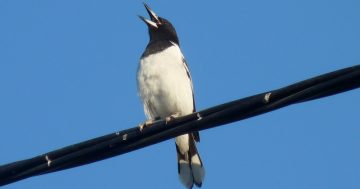
A Rainbow Lorikeet feeds on Callistemon flowers, a natural food. Photo: Ian Fraser.
As I write this in Canberra one sunny, breezy afternoon in early spring, the Rainbow Lorikeets are screeching and squabbling in the banksia flowers just off the balcony.
A few years ago this would probably only have happened at the coast, but it’s now a commonplace occurrence anywhere in Canberra. I saw my first one in Canberra in 2004, then there was a nine-year break before I encountered more. It’s only four years since I first saw Rainbow Lorikeets in Weston Creek but already it’s a regular event here.
They really must be among the most spectacular parrots in the world, let alone Australia, with a brilliant blue head and bright green back separated by a pale green collar, and bright red eye, bill and breast.
They are in-your-face birds, flashy in colour, behaviour and speed. They arrive in a rush of colour and loud harsh shrieks, and proceed to chase away anything who dares to be in their favoured tree or shrub, and abuse and threaten each other.
We used to assume the first ones we saw in Canberra had escaped from aviaries, and some may well have done, but we now know they are great colonisers, and spreading inland rapidly.
When I was living in Adelaide we never saw them, except for when the Lemon-scented Gums were flowering in the parklands through which we walked on our way to uni, when they turned up as if by magic, and disappeared again when the flowers were finished.
Now when I visit, they are everywhere, all the time, one of the most visible (and audible) birds in the city. Mum used to scold the little Musk and Purple-crowned Lorikeets when they insisted on taking nibbles out of each apricot and apple in the garden, to see how they were coming along.

A Rainbow Lorikeet inspects a breeding hollow at Callum Brae Nature Reserve, Canberra. Photo: Ian Fraser.
She was happy to share, but got frustrated at the waste of so much fruit. I’m glad she didn’t see the coming of the Rainbows, who stripped her trees in no time and would have defeated her.
Every time I drive inland it seems I’m surprised at how much further they’ve pushed away from the coast. Last year I saw them in Wagga Wagga for the first time. I suppose they follow flowering eucalypts, but doubtless get waylaid by orchards and gardens, and spread through towns as they reach them, gratefully harvesting flowers and fruit – and home bird feeders. And as they get established, people doubtless put out more food.
The First Fleet settlers probably didn’t encounter them regularly until they reached the Blue Mountains where Blue Mountain Lorikeet or Parrot, along with Blue-bellied Parrot, was the accepted name until into the 20th century.
However the first published illustration of an Australian parrot was of a Rainbow Lorikeet in 1772, 16 years before the Sydney settlement. This unfortunate bird was captured alive by Cook’s expedition at Botany Bay in 1770 and taken back to England, where it was later painted by Welshman Moses Griffith.
Edward Morris’s very thorough Dictionary of Austral English, published in 1898, didn’t know the name we use today, and John Leach, in the first field guide to Australian birds, only used Rainbow Lory as an alternative name. (Lory was a Malay-derived name, used widely for any parrot until the 20th century; lorikeet just meant ‘little lory’.)
Rainbow Lorikeet apparently appeared in print for the first time in an authoritative 1926 publication, and gained traction from there.

Rainbow Lorikeets rapidly learn to accumulate where food is provided; these are on the south coast. Photo: Ian Fraser.
Flocks will gather at food sources such as flowering trees, and the chaos is considerable. The famous Currumbin Sanctuary in south-east Queensland, where visitors have lorikeets clambering over them to receive food, is reported to attract up to 1000 lorikeets at a time. And huge numbers fly into the trees along the Cairns Esplanade to roost at night.
We don’t see that sort of drama in Canberra at the moment, but I can foresee the day when we could. Rainbow Lorikeets are here to stay, and are increasing all the time. For some years they have been breeding in tree hollows in nature reserves, a cause for some concern as they are so pushy and aggressive and readily evict other species from desirable accommodation.
How that part of the story of Rainbow Lorikeets in Canberra plays out remains to be seen, but meantime what is not in doubt is that our city is more colourful and lively for their coming.
Ian Fraser is a Canberra naturalist, conservationist and author. He has written on all aspects of natural history, advised the ACT Government on biodiversity and published multiple guides to the region’s flora and fauna.





















